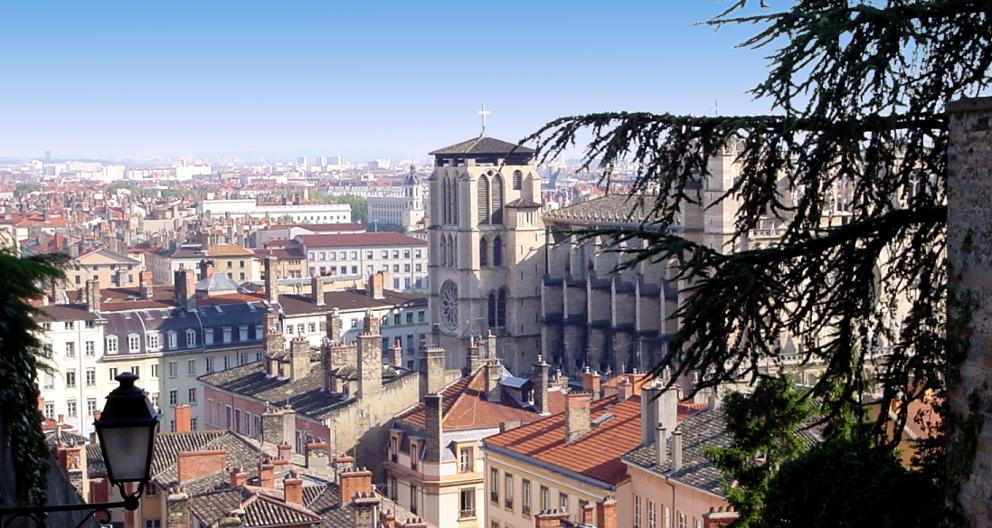
LYON - France's second city
Lyon - where to stay, what to see and do
- Explore France ►
- Essential pages
- Travel in France
- Where to go
- What to see and do
About-France.com
- the connoisseur's guide to France
Lyon - things to see and do
| On this page | Location and access | Tourist attractions |
| In the area | Hotels in Lyon |
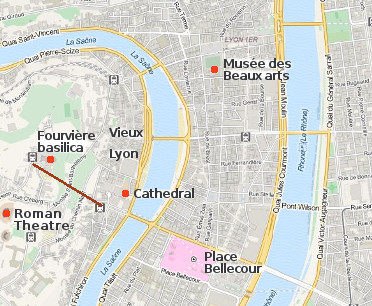 Central
Lyon - the old city and the Presqu'île.
Central
Lyon - the old city and the Presqu'île.Surprisingly for a city that until 2014 had no world-class museum, no great cathedral, and none of the top thirty tourist attractions in France, Lyon claims to be the second tourist destination in France after Paris, and ahead of Nice or Strasbourg.
But in fact, maybe this is not too surprising. Lyon is France's second city, one of France's oldest cities, and is reputed as the gourmet capital of France. It's large historic centre, Le Vieux Lyon, is a UNESCO World Heritage site, and is the largest ensemble of Renaissance buildings in Europe. In addition, Lyon also has a new museum which looks as if it may vie for celebrity with the Guggenheim museum in Bilbao. The new Confluences museum lies at the point where the Saône and Rhone rivers meet, and is a museum of science and anthropology, with plenty of interactive exhibits.
The confluence of these two great rivers is the hub of an urban area with over two million inhabitants. Lyon is also the main city on the road and rail routes between Paris and the south of France, Paris and the Alps and Italy, and northern Europe and Spain.
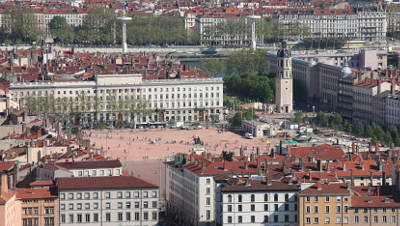 Place
Bellecour, seen from the view point at Fourvière.
Place
Bellecour, seen from the view point at Fourvière.Lyon Hotels
and apartments
1.
Hotels
Choose hotels by area of Lyon
- Central area - La Presqu'île, between the two rivers
- The old city, west of the Saône
- La Part Dieu - near the main railway station
A choice of hotels and apartments in Lyon.
These hotels are conveniently sited in or near the city centre, and all have good write-ups. Click links for details and to book at best rates .Five star hotels:
★★★★★
Hotel
Cour des Loges
Superb hotel
located in beautifully renovated Renaissance buildings in the heart of
Old Lyon. Spa, restaurant, hammam, garden, private parking (charge).Four star hotels:
★★★★
Hotel
Carlton
- Reasonably priced four star hotel on the Presqu'ile a few yards from
Place Bellecour and the central shopping area.Three star hotels
★★★
Recommended
...Hotel Mercure Lyon Beaux-arts
A three-star Mercure hotel between Musée des Beaux Arts and Place Bellecour.
Lots more three-star hotels
Click here for a full list of three star hotels in Lyon
Two star hotels
★★
Recommended
...
Hotel Elysee - on the Presqu'île between Place Bellecour and the Musée des Beaux arts. Lots of good reviews for this clean friendly two-star hotel
More two-star hotels
Click here for a full list of two star hotels in Lyon
2. Apartments - gites
Follow this link for short-stay apartments and click here for classic city gites
Hostels
See Hostels in LyonAs the gastronomic capital of France, it is a city with a huge selection of good restaurants – not just its top-of-the-range Michelin starred eateries, but also its many good traditional bistrots and small city restaurants offering top quality food and local specialities at reasonable prices. Located between the vineyards of Beaujolais and Burgundy to the north, and Côtes du Rhône to the south, Lyon is also a city where there are plenty of local wines to be sampled.
Founded by the Romans in 43 BC, Lyon was one of the most important cities of the Roman empire, and capital of Gaul, an area comprising most of modern France and Belgium. In the Middle Ages it was an important trading city astride the routes from Northwest Europe to the Mediterranean and to Italy. Later it became famed as the capital of the French silk weaving industry and then a major textiles centre. Today it is a major industrial and business hub with excellent rail and road links and one of France's busiest provincial airports.
Lyon tourist attractions
Perhaps the best way to begin a trip to Lyon is to start at Place Bellecour, the great piazza in the city centre between the Rhône and the Saône.Walk west from the northwest corner of the square, then cross the river Saone on the Pont Bonaparte bridge, and continue straight on for 100 metres until you see the station for the Funicular railway .Take line F2 up to the hilltop at Fourvière. From here, you can get your bearings as you look out over the city of Lyon at your feet.
Fourvière is home to Lyon's most emblematic monument, Notre Dame de Fourvière,
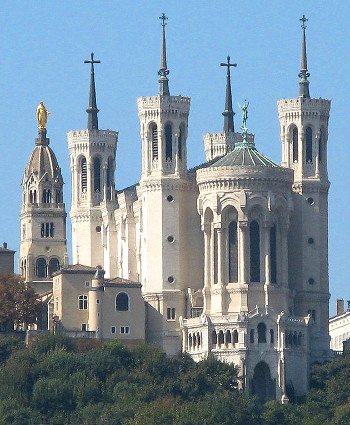
The basilica Notre Dame de Fourvière
A couple of hundred metres south of the Basilica lie the principal remains of the Roman city of Lugdunum, the Roman theatre and the smaller odeon. Long hidden from view, these were excavated in the twentieth century, and the theatre is now used in summer for the Nuits de Fourvière music festival.
From beside the basilica, visitors can then wander back down the hill, to discover on the west bank of the Saône the historic quarter of le vieux Lyon, a maze of narrow streets and historic buildings many dating from the Renaissance or earlier.
Among the musts in this part of old Lyon, in addition to the cafés and restaurants, are the "traboules", narrow Renaissance alleyways mostly running perpendicular to the river. Several of these are open to the public, and visitors can explore the interior courtyards and vaulted passages that characterise the historic city.
Also in the old city is the Cathedral Saint Jean, a medieval gothic cathedral most famed for its astronomic clock. Externally, Lyon cathedral is rather less interesting than the great gothic cathedrals of northern France.
From the old city, cross back over the Saône on the Passserelle du Palais de Justice footbridge, and back to the "Presqu'ile", the neck of land between the two rivers. At the end of the bridge, cross the road, and plunge into the narrow streets of the Presqu'île following the narrow pedestrianized rue de la Monnaie. There are lots of small cafés and restaurants in this and adjoining streets. You are never far from Place Bellecour, which is indicated on signs.
Running north from place Bellecour, up the centre of the Presqu'île, is the rue Edouard Herriot. It is a bit over a kilometre from the Place Bellecour to another great square the Place des Terreaux, on which stands the Lyon fine arts museum. While not on a par with the best Paris museums, it is one of the best provincial museums in France and has a good collection, from Egyptian and classical antiquities and decorative arts to paintings, and includes works by Veronese, Rubens, Tintoretto, the French Impressionists, Matisse, Picasso or Francis Bacon.
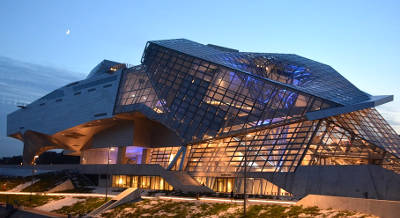 Lyon's new
Confluences museum of science and anthropology.
Lyon's new
Confluences museum of science and anthropology.Other interesting Lyon museums include the Textile Museum (near Place Bellecour), one of the best of its kind, the Modern Art Museum, the Lyon Cinema museum, and the Electricity museum.
Lyon has several festivals and hosts many special events. The city's Festival of Lights is a four day event culminating on 8th December. The Festival commemorates the sparing of Lyon from the plague in 1643. Many buildings are specially floodlit or lit up for the event, and people put candles on their windowsills all over town.
In June and July, the Nuits de Fourvière festival stages some fifty open air concerts and theatrical performances in the Roman theatre.
Seeing Lyon
There are several options for taking a tourist trip around Lyon. The first is on foot, which is great on a nice day: in addition, visiting Lyon on foot is the only way to see the narrow streets of Old Lyon, which is the most attractive and interesting part of the city. Take the funiculaire up to Fourvière, from the Old Town, just close to the Cathedral.For a longer visit, taking in a greater part of the city, try the tourist buses run by the Lyon Open tour; or take a boat trip on the Sâone and /or Rhône rivers. Departures from the Quai des Célestins, on the Saône, near Place Bellecour.
In the area - Around Lyon
Among places near Lyon that are worth visiting are the small medieval town of Pérouges, to the east, the vineyards of the Beaujolais area to the north of Lyon, and Vienne, beside the Rhône, to the south.Vienne is a small town with a rich historic heritage, including a very well-preserved Roman temple, the temple of Augustus and Livia, and a Roman pyramid. There is also a large Gallo-Roman theatre and a fine romanesque abbey with 12th century cloister, the best cloister in the Rhone-Alpes region.
For a day's outing in summer time, drive south to the small town of Tournon sur Rhône, for a trip on one of France's best scenic railways, the Chemin de Fer de l'Ardèche.
Further afield, but easily accessible, are the Alps. The lakeside resort of Aix les Bains can be reached by train from Lyon in 1 hr. 10 mins, and Chambéry in 1hr 20.
Copyright
© About-France.com 2007 - 2025 except where otherwise stated.
About-France.com
Home
page - Site
search
- Regions
- Maps of France
- Contact
Photo top of page: St.
John's cathedral and the roofs of old Lyon
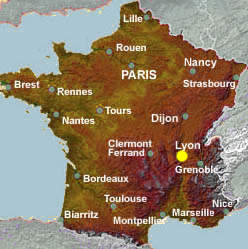
About-France.com is an independent user-supported website, and may receive commission from sales made on selected partner websites .
By
plane - Nearest airports: Lyon Saint
Exupéry, Geneva, Paris Charles de Gaulle (direct
TGV link).
By road : Lyon is 6 hours drive from Calais, 4 hours from Paris, and 2h from Geneva.
By train: direct TGV services from Paris (2 hours), Lille (3 hours), Strasbourg and Marseille. Regular international train services to Geneva and Turin. For timetables and online tickets (within France or international) see Trainline.com .

Region:
Rhone-Alpes
Nearby cities: Grenoble, Saint Etienne.
Lyon is in the Rhone valley.
Urban area Population 1.6 million
Main sites: The old city (UNESCO world heritage site), Notre Dame de Fourvière, St. John's Cathedral, the Musée des Beaux Arts, the Roman theatre.
Nearby attractions: Beaujolais and Côtes du Rhone vineyards, Vienne, the medieval city of Pérouges - and within just over an hour's drive, the Alps.
Accommodation:
See opposite or above (small screens).
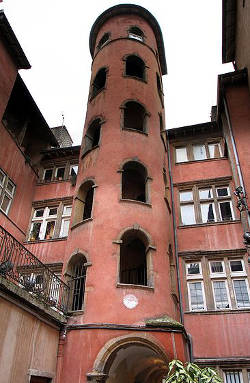
Renaissance houses in old Lyon
Copyright © About-France.com except Plan of Lyon from an open-source original from openstreetmap.org.
Photo top by Patrick Verdier Folp.free.fr. Place Bellecour by Otourly - licence GNU. Fourvière basilica by Mickael G, Renaissance house by Chris 73, - Creative Commons licence

About-France.com is an independent user-supported website, and may receive commission from sales made on selected partner websites .
Lyon in a nutshell :
Access - getting to Lyon
By road : Lyon is 6 hours drive from Calais, 4 hours from Paris, and 2h from Geneva.
By train: direct TGV services from Paris (2 hours), Lille (3 hours), Strasbourg and Marseille. Regular international train services to Geneva and Turin. For timetables and online tickets (within France or international) see Trainline.com .
Lyon train stations :
Lyon has two main train stations. All TGV high-speed train services come into Lyon Part Dieu station, on the east side of the Rhone. Some continue, along with many local trains, to the old main station at Perrache, on the Presqu'ile, 1 km south of Place Bellecour.The Lyon city card :
The Lyon City card, valid for 1, 2 or 3 days, provides free public transport, free entry to museums, a river cruise, guided tours and discounts on other attractions. To buy the Lyon City Card in advance online from Tiqets, click here or scan the QR code:
Location :
Nearby cities: Grenoble, Saint Etienne.
Lyon is in the Rhone valley.
Urban area Population 1.6 million
Main sites: The old city (UNESCO world heritage site), Notre Dame de Fourvière, St. John's Cathedral, the Musée des Beaux Arts, the Roman theatre.
Nearby attractions: Beaujolais and Côtes du Rhone vineyards, Vienne, the medieval city of Pérouges - and within just over an hour's drive, the Alps.
Accommodation:
See opposite or above (small screens).
Site
search
About-France.com
What are you looking for ? Where do you want to go?
About-France.com
What are you looking for ? Where do you want to go?
Football
/
Soccer
Lyon Olympic Stadium is the largest in France after the Stade de France, in Paris..
The venue hosted the semi final and for the final of the women's world cup in 2019, and will host 12 matches in the 2024 Olympic Games. It is located some 15 km east of the city centre, beside the E15 / N 346 Lyon eastern ring road.
Tram acces, Line T3, from Villette Sud, just outside Lyon La Part-Dieu TGV / train station . 20 minutes.
From LYS airport take Rhonexpress light rail to Meyzieu then change to T3 tram.
Lyon Olympic Stadium is the largest in France after the Stade de France, in Paris..
The venue hosted the semi final and for the final of the women's world cup in 2019, and will host 12 matches in the 2024 Olympic Games. It is located some 15 km east of the city centre, beside the E15 / N 346 Lyon eastern ring road.
Tram acces, Line T3, from Villette Sud, just outside Lyon La Part-Dieu TGV / train station . 20 minutes.
From LYS airport take Rhonexpress light rail to Meyzieu then change to T3 tram.

Renaissance houses in old Lyon
Click here for
low-cost car hire in France
low-cost car hire in France
Copyright © About-France.com except Plan of Lyon from an open-source original from openstreetmap.org.
Photo top by Patrick Verdier Folp.free.fr. Place Bellecour by Otourly - licence GNU. Fourvière basilica by Mickael G, Renaissance house by Chris 73, - Creative Commons licence
